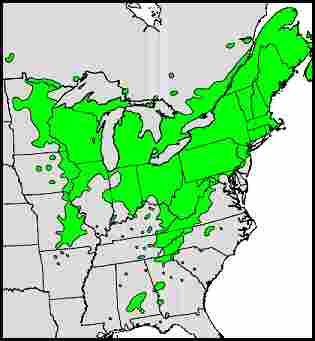Pagoda Dogwood
(Cornus alternifolia)
The Pagoda Dogwood is a small understory tree native to much of the eastern United States. It gets its common name from its pagoda-like horizontal branching pattern. An older name, Pigeonberry, refers to the fruits, which were once a favorite food of the now-extinct passenger pigeons. Its scientific species name, alternifolia, relates to the leaf pattern, which, unlike most dogwoods, alternates along the stem.
This plant's blossoms aren't as showy as those of the common Flowering Dogwood, but they are still attractive. They are creamy or yellowish white, very fragrant, and form clusters at the ends of branches. The flowers are followed by berries that gradually change from green to red to blue-black, on red stalks. These berries are a valuable food for birds and other wildlife.
The leaves can turn to a beautiful reddish-purple before they drop in autumn. The color varies from tree to tree, and may partly depend on growing conditions. The light brownish-gray bark, together with the interesting branching structure, give the plant winter appeal.
This species is found over a large part of the eastern United States, but there are small genetic differences between plants from different regions. For this reason, plants grown from a southern seed source may not do well in the north, and vice-versa. Northern-adapted plants are very cold-hardy, and can be grown in Zone 4 and the warmer parts of Zone 3.
Pagoda Dogwood is susceptible to a number of diseases, including twig blights and cankers. But the species appears to be resistant to Dogwood Anthracnose, which in recent years has killed many Flowering Dogwoods.
Other Information
Scientific Name: Cornus alternifolia
Common Names: Pagoda Dogwood, Alternate-leaf Dogwood, Pigeonberry
Plant Type: Small deciduous tree
Height: up to 25 feet
Cultivation Zones: 4 - 8
Native Habitat: Understory of mixed forests
Native Range: Much of the eastern U.S., especially northern regions. See distribution map below.
Distribution Map

Range Map Source: U.S. Forest Service. (See General Note C)
Conservation Status: NatureServe lists Cornus alternifolia as Imperiled in Delaware, Florida, and Mississippi. Officially the species is classified as Endangered by Florida.
Cultivation: This plant is shade-tolerant, but will look and perform better in sunlight. Give it slightly-acid well-drained soil and water young plants during dry spells. Go to Cultivation for more information.
Plant Sources: Possible sources of Pagoda Dogwood include Shooting Star Nursery, Meadowbrook Nurseries, Forest Farm, Nearly Native Nursery, Elk Mountain Nursery, and Lazy S's Farm. For links to these suppliers, go to Sources of Plants.
|

